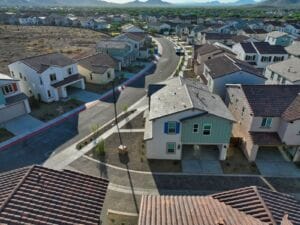With the widespread rollout of COVID-19 vaccines beginning in early 2021, local vaccination rates were found to have little impact on housing market performance or long-term, strategic housing decisions – but did lengthen transaction times in less-vaccinated areas. But the spread of more-transmissible variants has weakened that relationship, pointing to a future in which broad-based housing market dynamics are unlikely to be meaningfully disrupted by the still-unfolding pandemic.
The COVID-19 pandemic has introduced new challenges to real estate transactions. In-person interactions carry the risk of COVID transmission and high infection rates make open houses and other marketing strategies infeasible. However, the rise of highly effective vaccines has mitigated some of these complications. How has vaccination affected transaction speed and volume? Zillow found that homes for sale in areas with a greater vulnerability to COVID-19 – characterized in this analysis as areas with lower overall vaccination rates – typically spent slightly longer on Zillow until a pending sale, compared to their historical average time on market. However, measures of inventory, sale volume and price appear to be unaffected by local vaccination rates.
READ ALSO: The 3 hottest neighborhoods in Arizona
The analysis bolsters the idea that while COVID-19 can impact the mechanics of the transaction itself, it has much more limited (if any) impact on the underlying supply of and demand for housing. Additionally, we found the arrival of new, more-transmissible virus strains – like omicron – may further reduce the difference between highly-vaccinated and less-vaccinated areas in the time homes spend on market before selling.
Zillow’s analysis of local vaccination data and data on local home inventory, sales volumes, home prices and time on market found that:
• Homes in metro areas with a lower vaccination rate take longer to sell. If the vaccination rate in Atlanta (which had the lowest overall vaccination rate among metro areas analyzed at the time of analysis) was the same as the vaccination rate in San Francisco (the highest among metros analyzed), homes in Atlanta could be expected to sell two days sooner.
• The vaccination rate does not affect other measures of supply, demand, and price. Pandemic conditions do not appear to affect these long-term, forward-looking decisions.
• The arrival of the delta variant of COVID-19 weakened the association between vaccination rates and time to sell. This suggests that the arrival of the omicron variant may further reduce any time-on-market advantage of highly-vaccinated metros over less-vaccinated ones.
An overview of vaccination data
County-level data on vaccination rates was obtained from the Centers for Disease Control and mapped to Zillow metro areas, giving us a daily vaccination share by metro area. [1] From this data set, we built a metro-level measure of “COVID-19 vulnerability” as follows:
• Prior to the arrival of the World Health Organization declaration of a COVID-19 pandemic, [2] each metro area was assigned a vulnerability level of zero.
• After this, a metro area’s COVID-19 vulnerability is the percentage of the population in the metro who are not fully vaccinated (with either one dose of a one-dose vaccine or two doses of a two-dose vaccine).
This measure does not fully reflect the vulnerability of the population to COVID-19. Infections were present prior to the declaration of a pandemic, and breakthrough infections can occur in fully vaccinated people. However, this measure arguably captures the salience of COVID-19 to the prospective homebuyer as well as the stringency of regulations that would affect homebuying.
But while the onset of the pandemic was essentially the same everywhere, the subsequent rate of vaccination varied widely by metro. As shown, different metro areas have very different trajectories in their exposure to COVID-19. We can use this variation to measure how COVID-19 vulnerability affects housing transactions.
COVID-19 vulnerability and housing market outcomes
We examine how COVID-19 vulnerability affects several housing market outcomes. Our analysis removed national-level variation over time (e.g., changes in interest rates) and time-invariant metro-level variation (e.g., differences in local attitudes towards vaccination) to isolate the within-metro, across-time variation in COVID-19 vulnerability. [3]
Specifically, we considered the following variables:
• The number of units for sale
• The number of new listings
• The number of new sales
• The median sale price
• The median days on Zillow until a pending sale
For the first four variables, we find no statistically or economically significant relationship. However, we do find a meaningful relationship between COVID-19 vulnerability and the duration on Zillow until a pending sale. Specifically, for each ten percentage points of COVID-19 vulnerability, the median duration on Zillow until a pending sale increased by 3.1%. [4] Put another way: Suppose Atlanta (the least-vaccinated major metro) increased its vaccination rate to the level of San Francisco (the most-vaccinated major metro), holding all else equal. Then, the median time until a pending sale in Atlanta at the time of analysis would be expected to decrease from fourteen days to twelve days. [5]
The four variables with no relationship to current vaccination rates all relate to longer-term, forward-looking, more “strategic” decisions to buy and sell homes. Therefore, it may be unsurprising that they are not sensitive to current vaccination rates. Conversely, the duration until a sale depends on agents’ abilities to market the home and the ability of prospective homebuyers to view the home. Vulnerability to COVID-19 appears to affect these short-term home sale dynamics.
The onset of the delta variant
At the time of writing, the omicron variant of COVID-19 has become the dominant variant in the United States. This new variant is much more transmissible than previous strains. How will the rise of this new variant affect the housing market?
We can gain insight by examining the onset of the delta variant. Specifically, we can redo the analysis in the previous section but with separate coefficients for the periods before and after the dominance of the delta variant in the United States.[6] This allows us to measure how COVID-19 vulnerability affected housing transactions before and after the arrival of the delta variant.
Our results suggest that the arrival of the delta variant decreased the effect of COVID-19 vulnerability on the median duration on Zillow until a pending sale. Prior to the delta variant, a ten percentage point increase in COVID-19 vulnerability corresponded to a 9.6% increase in days on Zillow until a pending sale. [7] With the delta variant, a ten percentage point increase in COVID-19 vulnerability corresponded to an increase of just 0.7%. [8]
Increases in COVID-19 infection rates or a reduction in the perceived protection of vaccination after the arrival of the delta variant may have made agents and buyers more cautious about the homebuying process. The omicron variant appears to be even more infectious. This is likely to further erode any difference in the days until sale between highly-vaccinated metros and less-vaccinated metros.




